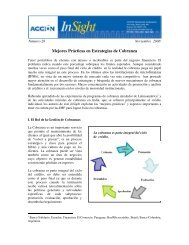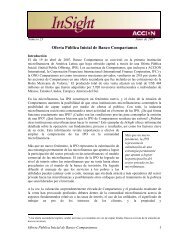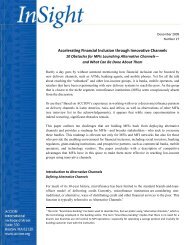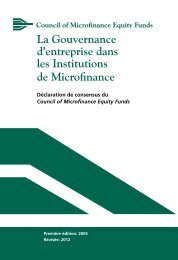the Universal Standards for Social Performance Management
the Universal Standards for Social Performance Management
the Universal Standards for Social Performance Management
Create successful ePaper yourself
Turn your PDF publications into a flip-book with our unique Google optimized e-Paper software.
do not provide group lending.4. Design Products, Services, Delivery Models and Channels that Meet Clients’ Needs and PreferencesOverall Comments on this SectionWith an average overall completion rate of 83.7%, and a standard deviation of 15%, this section ranked first interms of compliance, with <strong>the</strong> smallest standard deviation. This suggests that organizations have a high opinion of<strong>the</strong>ir current products, services, delivery models, and channels.The Essential Practices in this section were seen as applicable and achievable, though <strong>the</strong>re were somesuggestions (outlined below) to improve clarity and measurability.Specific Practices of Note (easiest, most difficult, inapplicable, confusing, etc.)The EPs in 4a (“The institution understands <strong>the</strong> needs and preferences of different types of clients”) weregenerally seen as more difficult to achieve. In addition, some MFIs reported that <strong>the</strong>y did not know how tomeasure compliance against <strong>the</strong>se EPs. The indicator release may be helpful in this regard.Additionally, 4b2 ("Loan repayment schedules correspond with <strong>the</strong> expected cash flows of borrowers") was oftencited as more difficult <strong>for</strong> institutions to achieve.There appears to be some repetition in <strong>the</strong> EPs in 4b with o<strong>the</strong>r areas of <strong>the</strong> USSPM, <strong>for</strong> example:4b2 “Loan repayment schedules correspond with <strong>the</strong> expected cash flows of borrowers” could beconsidered to be part of 3a: “The institution determines that clients have <strong>the</strong> capacity to repay. . .”4b4 “Products are af<strong>for</strong>dable to clients, meaning clients will not have to make significant sacrifices to <strong>the</strong>irstandard of living or business affairs. . .” is encompassed in Section 6: “Pursuit of profits does notundermine . . . client well-being.”The EP identified as problematic by <strong>the</strong> most institutions was 4b9: “The institution has two credit policies in place:1) a policy describing acceptable pledges of collateral – including not accepting collateral that will depriveborrowers of <strong>the</strong>ir basic survival capacity, and offering an explanation of <strong>the</strong> role of guarantors; <strong>the</strong> policyguarantees clients receive a fair price <strong>for</strong> any confiscated assets; and 2) a policy to actively work out solutions <strong>for</strong>rescheduling loans/writing off on an exceptional basis <strong>for</strong> clients who have <strong>the</strong> ‘willingness’ to repay but not <strong>the</strong>capacity to repay.”One MFI was confused by what "acceptable" collateral would entail (because, according to <strong>the</strong> MFI, institutionsserving <strong>the</strong> very poor must accept collateral that could deprive clients of basic survival if <strong>the</strong>y are to serve <strong>the</strong>m atall. Fur<strong>the</strong>r, <strong>the</strong>y cannot guarantee market price because <strong>the</strong>y need to sell quickly). O<strong>the</strong>r MFIs thought that oneor more parts of this EP were not universal. In general this EP has too many concepts in it and should besimplified.Additionally, <strong>the</strong>re was some confusion about:4b6 “Product terms and conditions are easy <strong>for</strong> clients to understand and compare” was seen as hard tomeasure. What constitutes easy from <strong>the</strong> client’s perspective?4b7 “Changes to <strong>the</strong> product (cost, terms, conditions) are minimal and infrequent” needs to be clarifiedsince some product changes are necessary and driven by demand.4c2 “Providing timely access to sufficient money and services that allow clients to reduce <strong>the</strong>ir risk andcope with common emergencies. . .” should define “timely access” and “emergencies.”19
















